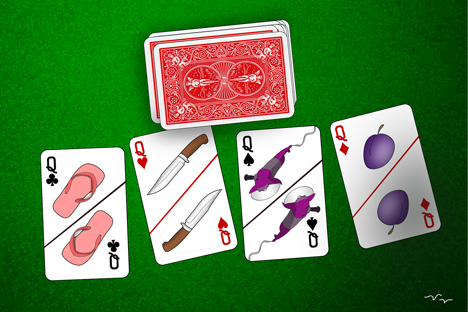
Click to enlarge the image. Drawing by Niyaz Karim
An Englishwoman is a national of England. A Frenchwoman is a national of France. However, in the Russian language, the names of female representatives of a number of nations have alternative meanings – some of them fairly obvious in their origins and others altogether obscure and inscrutable.
I have written elsewhere that yaponka (a “Japanese woman”), in its modern colloquial usage, refers to a Japanese car and nemka (a “German woman”) to a German one. But then, amerikanka (an “American woman”) is not a Ford or a Buick, but a game of Russian billiards with a very particular set of rules.
Gollandka (a “Dutchwoman”) is an old name for a stove found inside a residence, lined with special tiles; today, when stoves are seldom used for heating, this use of the word gollandka has become archaic.
The second meaning of the word ispanka (a “Spanish woman”) has likewise become outdated - a hundred years ago, it referred to a much dreaded virus (Spanish flu) that claimed the lives of dozens of millions of people in the 1918-1919 pandemic.
The word finka (a “Finnish woman”) was commonly used in the post-World War II Russia of the 1940s-1950s, when crime was rampant throughout the country. Finka was the short name of a knife with a thick stubby blade (the Finnish knife), which was popular with the criminals.
But as for the name of a female resident of another country on the Baltic, litovka (a “Lithuanian woman”), it signified a large scythe with a long handle. A rather more complex tool, the angle-grinder - a special grinding machine used for cutting and stripping metal, stone and other hard materials - is known by the name bolgarka (a “Bulgarian woman”).
Shotlandka (a “Scotswoman”) describes tartan - a traditional Scottish polychromatic fabric in a plaid pattern that never seems to go out of fashion. One of the meanings of the word vengerka (a “Hungarian woman”) also falls into the garment category, referring to a short jacket with horizontal cords sewn onto the breast. But more commonly, vengerka is a certain variety of prune plum.
Two other foreign ladies are associated with light footwear: special slippers used by gymnasts called cheshki (“Czech women”) and flat beach shoes with two straps attached to a toe post, known as flip-flops in English and vyetnamki (“Vietnamese women”) in Russian.
Russian cars: The ‘tachka,’ ‘inomarka’ and ‘yaponka’
Vova, Vladimir, Vladimir Vladimirovich: What do Russian names mean
Polka (a “Polish woman”) is a once-popular folk and ballroom dance, traditionally performed in pairs (a curious aside: the dance, which emerged in the early 19th century, is in fact Czech, rather than Polish, in its origin).
Another ethno-feminine musical nickname was given to a type of Russian accordion, which at the end of the 19th century was known by the name of talyanka (a slightly truncated form of italyanka, an “Italian woman”). However, this colloquial musical term has since fallen out of use.
Two famous geographical names draw on the same quirky tradition. And whilst the name of one of them, a neighbourhood of Odessa called Moldavanka, undoubtedly has to do with the city’s proximity to Moldova, the Moscow suburb Kubinka (a “Cuban woman”) has no relationship to Cuba. Nevertheless, if you are traveling from Moscow to Europe by train, you are bound to pass this inexplicable “Cuban” along the way.
A few other similarly coined colloquialisms are not, strictly speaking, eponymous with foreign nationals of the fairer sex, but bear close resemblance to them, merely omitting a suffix. A woman from Turkey is called a turchanka and a woman from Greece a grechanka.
As for their curtailed derivatives, turka refers to a particular conical metal vessel for brewing coffee, which hails from Turkey (making the origin of the word obvious and sensible); grechka is buckwheat, a domestically grown grain used for making very popular porridge (the connection with Greece dates back to the time when the cereal, imported from Greece, was first introduced to Russia).
Last but not least, the Asians indianka (an “Indian woman”) and koreiyanka (a “Korean woman”) also have their abridged counterparts: indeika and koreika: where the former refers to a female turkey and the latter to a dorsal cut of lamb, beef of pork, which includes bones.
As for the all-encompassing inostranka (a “female foreigner”), the word has had several casual uses related to literature. To begin with, it became a conversational abbreviation for the Library of Foreign Literature, which opened in Moscow in 1924.
Soon after its inception in 1955, a literary magazine called Foreign Literature became known under the same abridged name. And in 2000, the magazine’s editorial staff founded a publishing house called Inostranka, thus lending the vintage colloquialism an official brand status.
All rights reserved by Rossiyskaya Gazeta.
Subscribe
to our newsletter!
Get the week's best stories straight to your inbox